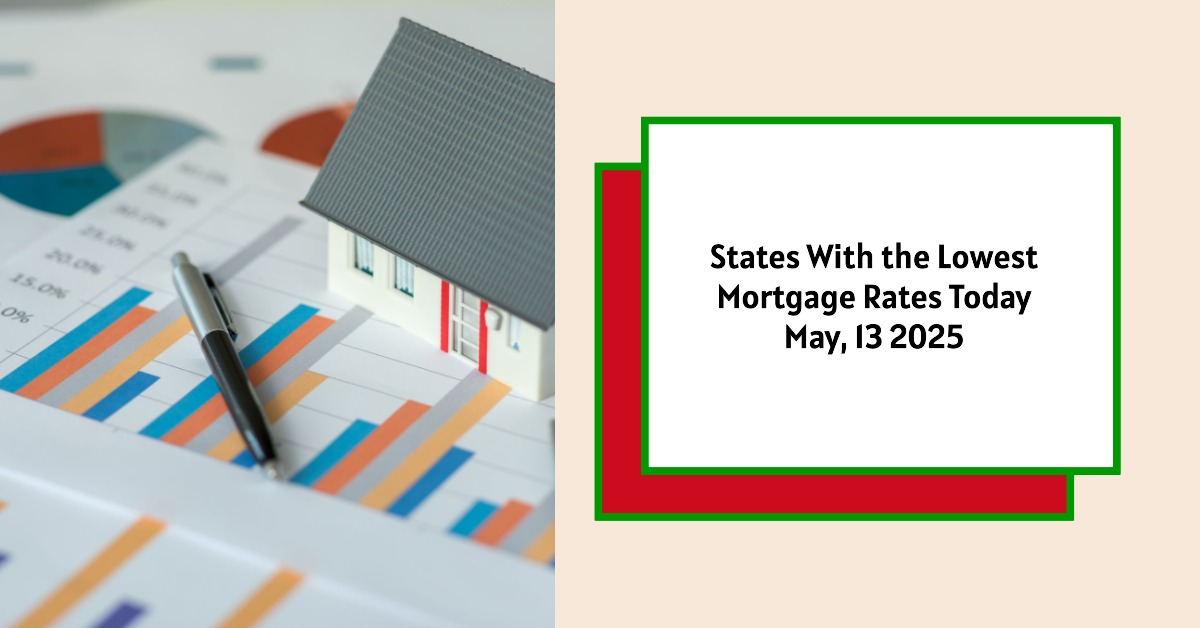For anyone dreaming of owning a home, or even just keeping their current one affordable, understanding where to find the lowest mortgage rates is paramount. As of today, May 13, 2025, the states offering the most attractive interest rates on 30-year new purchase mortgages might surprise you. According to the latest data, the five states boasting the lowest mortgage rates are New York, California, Texas, Florida, and Pennsylvania. Interestingly, these also happen to be the five most populous states in the nation.
States With the Lowest Mortgage Rates Today – May, 13 2025
Now, I know what you might be thinking. What's the connection between population size and lower mortgage rates? It's a valid question, and the answer lies in a mix of factors. These large states often have a higher volume of mortgage lenders operating within their borders. This increased competition can naturally drive rates down as lenders vie for your business. Furthermore, these states tend to have diverse economic activity, which can influence the overall risk assessment by lenders.
Following closely behind these giants, the states with the next best mortgage rates include Georgia, Hawaii, Virginia, and Washington. On May 13, 2025, the average rates in these nine states hovered between a comfortable 6.84% and 6.98%. On the other end of the spectrum, if you were looking for a mortgage in Alaska, West Virginia, North Dakota, Vermont, Maine, Mississippi, New Mexico, Nevada, or Wyoming, you would likely encounter the highest average rates, ranging from 7.06% to 7.26%.
It's fascinating to see such a clear regional disparity in mortgage rates. It really highlights that the housing market isn't a monolithic entity; it's a patchwork quilt of local economies, regulations, and lender appetites.
Why the Rate Rollercoaster? Unpacking the Factors Behind State-Specific Mortgage Rates
You might be wondering why your neighbor across state lines could be looking at a significantly different interest rate than you. Several key factors contribute to these state-level variations in mortgage rates.
- Lender Presence and Competition: As I touched upon earlier, the sheer number of mortgage lenders operating in a state plays a big role. More lenders typically mean more competitive pricing. Think of it like any other market – when there are more options, businesses have to work harder to attract customers, and one way they do that is by offering better rates.
- Credit Score Landscape: Believe it or not, the average credit score of borrowers within a state can influence the rates offered. States with a generally higher average credit score might be seen as less risky by lenders, potentially leading to slightly lower rates across the board.
- Average Loan Size: The typical amount people borrow for a mortgage in a specific state can also have an impact. In areas with higher average home prices (and thus larger loan sizes), lenders might adjust their rates based on the overall risk associated with larger sums.
- State-Level Regulations: Each state has its own set of regulations governing the mortgage industry. These rules can affect the operational costs for lenders, which in turn can be reflected in the interest rates they offer.
- Lender Risk Management: Ultimately, each lending institution has its own way of assessing and managing risk. This internal strategy can significantly influence the rates they are willing to offer in different regions. A lender might have a larger appetite for risk in one state compared to another based on their past experiences and market analysis.
It's crucial to remember that these factors often intertwine and influence each other in complex ways. There's no single magic bullet that dictates mortgage rates in a given state.
Beyond the Averages: Why Individual Rates Can Still Vary Widely
While it's helpful to understand the average mortgage rates in your state, it's equally important to recognize that your personal rate will be unique to your financial situation. The averages we see are just a snapshot, a general trend. Several factors will determine the specific interest rate you qualify for:
- Your Credit Score: This is arguably one of the biggest drivers of your mortgage rate. A higher credit score signals lower risk to lenders, translating into more favorable interest rates.
- Your Down Payment: The amount of money you put down as a down payment significantly impacts the loan-to-value (LTV) ratio. A larger down payment means you're borrowing a smaller percentage of the home's value, which lenders see as less risky. This often results in a lower interest rate.
- Loan Type and Term: The type of mortgage you choose (e.g., fixed-rate vs. adjustable-rate, FHA, VA, conventional) and the length of the loan term (e.g., 15-year vs. 30-year) will directly influence your interest rate. Shorter terms typically come with lower rates but higher monthly payments.
- Your Income and Debt-to-Income Ratio (DTI): Lenders will assess your income and existing debt to ensure you can comfortably afford the monthly mortgage payments. A lower DTI is generally viewed favorably.
- Points: You might have the option to pay “points” upfront to lower your interest rate. This is essentially pre-paying some of the interest. Whether this is a good strategy depends on how long you plan to stay in the home.
Therefore, while knowing the average rates in states with the lowest mortgage rates today is a great starting point, it's essential to focus on strengthening your own financial profile to secure the best possible rate for your individual circumstances.
My Two Cents: Why Shopping Around is Always the Smart Move
If there's one piece of advice I can give anyone looking for a mortgage, it's this: shop around! Don't settle for the first offer you receive. Mortgage rates can vary significantly between different lenders, even within the same state.
Think of it like buying anything else – you wouldn't just walk into the first store and buy the first item you see without comparing prices, would you? The same principle applies to mortgages, arguably one of the biggest financial commitments you'll ever make.
By getting quotes from multiple lenders, you can compare their interest rates, fees, and terms. This empowers you to make an informed decision and potentially save thousands of dollars over the life of your loan. Don't be afraid to negotiate and let lenders know you're comparing offers. They may be willing to adjust their rates to earn your business.
Read More:
States With the Lowest Mortgage Rates on May 12, 2025
Projected Mortgage Rates for the Week of May 5-11, 2025
When Will Mortgage Rates Go Down from Current Highs in 2025?
National Trends: A Broader Look at the Mortgage Landscape
While we've focused on state-specific data for May 13, 2025, it's also helpful to consider the broader national trends in mortgage rates. According to data, the average rate for a 30-year new purchase mortgage nationally stood at 7.00% on Monday. This reflects a slight increase after a couple of days of decline.
Interestingly, earlier in the year, in March 2025, we saw a low point with the 30-year average dipping to 6.50%. This just goes to show how dynamic the mortgage market can be, influenced by a complex interplay of economic factors, including the bond market and the Federal Reserve's monetary policy.
Understanding these national fluctuations can provide context for the state-level variations we've discussed. When national rates are generally lower, you might see more states offering particularly attractive deals. Conversely, when national rates rise, even the states with the lowest rates will likely see some upward pressure.
The Bottom Line: Knowledge is Power in the Mortgage Game
Understanding which states currently boast the lowest mortgage rates is a valuable piece of information for prospective homebuyers. As of May 13, 2025, New York, California, Texas, Florida, and Pennsylvania lead the way. However, remember that these are just averages, and your individual rate will depend on your unique financial profile.
The key takeaway here is to be proactive. Research the mortgage market in your state, compare offers from multiple lenders, and focus on improving your creditworthiness and down payment. By being informed and diligent, you can navigate the mortgage process with confidence and secure the best possible terms for your dream home.
Work With Norada, Your Trusted Source for
Real Estate Investment in the U.S.
Investing in turnkey real estate can help you secure consistent returns with fluctuating mortgage rates.
Expand your portfolio confidently, even in a shifting interest rate environment.
Speak with our expert investment counselors (No Obligation):
(800) 611-3060
Also Read:
- Will Mortgage Rates Go Down in 2025: Morgan Stanley's Forecast
- Expect High Mortgage Rates Until 2026: Fannie Mae's 2-Year Forecast
- Mortgage Rate Predictions 2025 from 4 Leading Housing Experts
- Mortgage Rates Forecast for the Next 3 Years: 2025 to 2027
- 30-Year Mortgage Rate Forecast for the Next 5 Years
- 15-Year Mortgage Rate Forecast for the Next 5 Years
- Why Are Mortgage Rates Going Up in 2025: Will Rates Drop?
- Why Are Mortgage Rates So High and Predictions for 2025
- Will Mortgage Rates Ever Be 3% Again in the Future?
- Mortgage Rates Predictions for Next 2 Years
- Mortgage Rate Predictions for Next 5 Years
- Mortgage Rate Predictions: Why 2% and 3% Rates are Out of Reach
- How Lower Mortgage Rates Can Save You Thousands?
- How to Get a Low Mortgage Interest Rate?
- Will Mortgage Rates Ever Be 4% Again?


